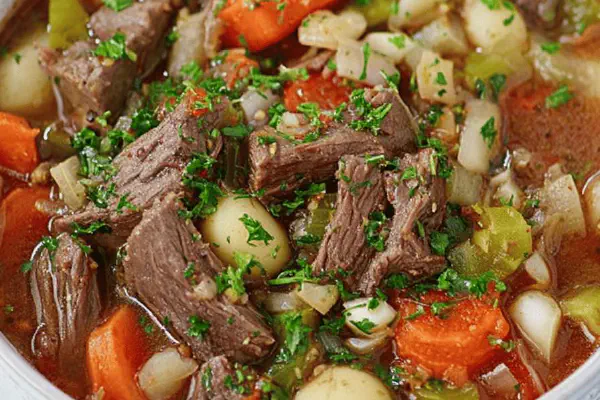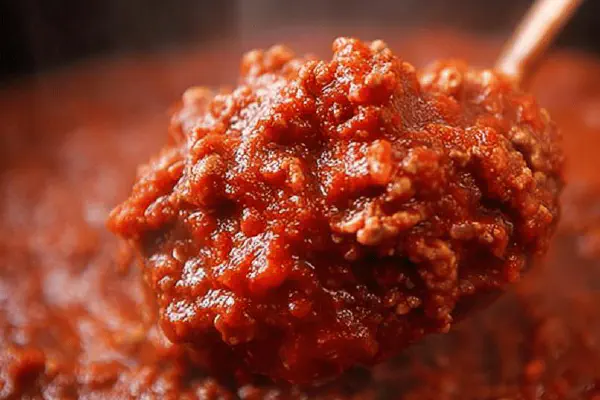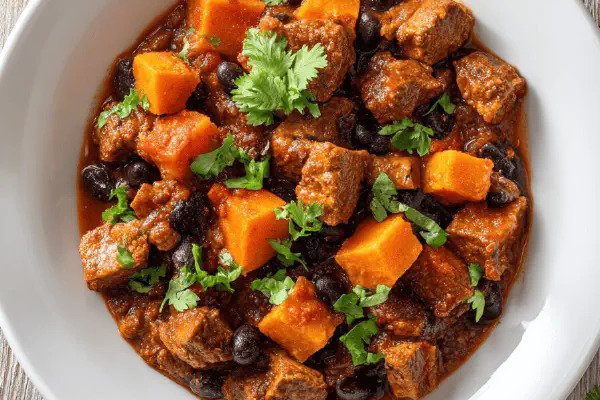Chunky Short Rib Chili

By Emma
Certified Culinary Professional
Ingredients
- 2 lbs beef short ribs, trimmed and patted dry
- 2 tbsp olive oil, divided
- 1 large onion, diced
- 2 celery stalks, diced
- 2 carrots, diced
- 1 can (4.5 oz) fire-roasted diced green chilies, drained
- 1 tbsp chili powder
- 1 can (15 oz) pinto beans, drained and rinsed
- 1 can (14 oz) diced tomatoes, undrained
- 4 cups beef broth, low sodium
- Kosher salt, to taste
- Freshly ground black pepper, to taste
- 1 tsp Aleppo pepper, plus more if desired
About the ingredients
Method
- Heat 1 tbsp olive oil in a large Dutch oven over medium. Oil shimmers but not smoking.
- Pat short ribs bone dry on all sides. Salt and pepper lightly, no drowning the beef.
- Brown ribs in three batches. Don't crowd pan—crowding steams, no crust. Turn to brown every side, deep mahogany crust. Remove to plate. Wipe excess fond if burning, but keep brown bits.
- Add remaining olive oil if pan looks dry. Toss in onions, celery, carrots. Stir gently 1-2 minutes until vegetables start feeling soft, edges translucent, but not caramelized. Listen for light sizzle, smell sweetening.
- Dump in drained green chilies, chili powder, pinto beans, tomatoes with juice, and beef broth. Stir gently to combine.
- Nestle short ribs back in. Lower heat to barely a simmer; bubbles barely breaking surface. Cover loosely, cook 35-45 minutes. Check bottom occasionally; stir to prevent sticking but not disruption of crust bits.
- Test largest rib for doneness—meat no longer pink inside, tender enough to bite cleanly but not falling apart. Remove all ribs carefully. Chop coarsely or shred off bones, discard fat caps and silver skin. Hands or forks work, but keep chunks large enough to bite.
- Return meat to pot. Taste. Adjust seasoning with kosher salt, fresh ground pepper. Shake in Aleppo pepper for gentle heat, smoky warmth.
- Serve hot. Thick bread or simple salad pairs well. Leftover flavor deepens—hold in fridge overnight if possible.
Cooking tips
Chef's notes
- 💡 Dry ribs well before browning. Wet ribs steam, no crust forms. Pat with paper towels. Salt lightly just before searing, holds moisture better to get deep mahogany crust. Use medium heat olive oil; too hot makes oil smoke and bitter burnt taste. Brown in small batches. Don’t crowd pan. Crowding means no crust, just boiled meat. Turn ribs slowly, keep patience. Look for crust color—not burned but rich and dark.
- 💡 Veggies sweat just long enough for translucence, edges soften but no caramelizing. Onion releases sweet smell, celery and carrots soften for mellow base. Listen for soft sizzling but no splattering or browning. Add chilies and beans once veggies give slight softness, that timing key to prevent gritty beans or burnt veggies. Fire-roasted chilies add subtle smoke; drain well to reduce watery broth.
- 💡 Simmer on barely bubbling surface, not rolling boil. Low heat preserves meat texture, keeps ribs intact long enough to tenderize slowly. A dry bottom scorches wrong; stir gently, scrape bits back in but no aggressive stirring to avoid breaking shredded chunks later. Cover loosely to vent pressure; too tight traps steam, makes meat mushy or flavors dull. Oven low-temp and covered pot works fine too, switch heat source if pan bottom too hot.
- 💡 Shred meat carefully; keep chunks large. Silver skin and fat caps discarded—they turn gritty or greasy when cooked long. Hands or forks work. If ribs fall apart easily, means overcooked but still tasty, just break less next time. Reintroduce meat late so seasoning not diluted. Salt and add Aleppo pepper at end; fresh Aleppo gives fruity warmth, avoid too early or heat fades during simmer. Swap with smoky paprika or cayenne if preferred heat profile differs.
- 💡 Leftover chili flavor deepens in fridge overnight. Thicken if watery later by simmer or add masa harina slurry. Serve with rustic bread or crisp salad to cut richness. Keep bones when trimming; roast and freeze for future beef stock. Beans drain and rinse to control salt and starchiness. Timing flexible, but watch bottom carefully. No rush on building flavor—slow patience beats fast cooking, especially for tough short ribs.
Common questions
How to get crust without burning?
Use medium heat, olive oil. Dry ribs fully. Salt last minute. Brown in batches—avoid crowding. Turn slowly. Watch color—dark mahogany, not black. Oil not smoking. Patience on flipping.
Can I swap beans?
Pinto beans best for creamy texture. Black beans hold shape but less rich. Chickpeas too gritty, kidney beans too firm. Rinse all well to reduce starch and salt load. Drain chilies to control broth moisture too. Fresh green chilies could replace fire-roasted but lose smoky note.
My chili is bitter, why?
Overheated oil burns, bitter taste. Also, burned fond pieces trap bitterness. Use good medium heat, wipe pan if burning starts. Avoid caramelizing veggies too much; gentle sweat for sweetness. Low simmer keeps flavors balanced—high heat can scorch acidity harsh.
How store leftovers?
Cool fast, fridge up to 4 days. Reheat gently on stove or microwave to preserve texture. Freeze in airtight container up to 3 months. Defrost slow in fridge. Avoid repeated reheats; meat toughens. Add fresh seasoning after reheating, Aleppo pepper holds well.



